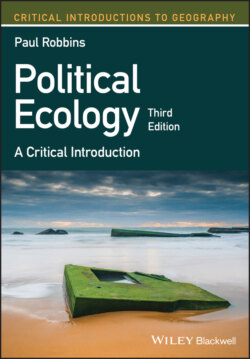Читать книгу Political Ecology - Paul Robbins - Страница 42
System, function, and human life: mature cultural ecology
ОглавлениеBut long before such approaches emerged, the science of cultural ecology would develop into a complex and diverse field of study in its own right, propelled by simultaneous enthusiasm in geography and the emerging sub‐discipline of ecological anthropology, and drawing upon an increasingly sophisticated body of concepts and quantitative methods (Grossman 1977; Hardesty 1977). In particular, the science of ecology provided the central analytical tools with which cultural ecologists would experiment. These were attractive because they allowed researchers to discuss human behaviors and practices in terms of their function and role in regulating energy and nutrient flows in a larger system, towards or away from homeostatic equilibria (Foote and Greer‐Wooten 1968). In other words, by viewing humans as essentially the same as other plant and animal species, basic functional hypotheses could be proposed to explain complex cultural patterns. Rituals, kinship patterns, and traditional institutions could be evaluated to determine if they served an ecosystem function – one that helped regulate the general system of human–environment relations, maintaining stability.
In a classic example, Roy Rappaport, an anthropologist with years of field experience amongst the Maring people of New Guinea, proposed that major features of the Maring's complex culture could be explained by virtue of their role in maintaining ecosystemic balances. Specifically he hypothesized that periodic ritual warfare and pig sacrifice were the indirect response mechanisms to cycles of population growth and decline amongst both pigs and people (Rappaport 1967, 1968).
Other researchers used ecological concepts like “ecological niche” and “adaptation” to explore within‐ and across‐group relationships (Barth 1956; Hardesty 1975). In the adaptation research of John Bennett, for example, the practices of a range of ethnic groups on the northern plains of Alberta, including Hutterite farmers, Anglo ranchers, and Native Americans, were explained in terms of the different ways in which they made a living from the diverse resources of the prairie (Bennett 1969).
During the 1960s and 70s, cultural ecologists became increasingly interested in developing common metrics with which such meaningful cross‐cultural measurements and comparisons might be made. How can the patterns of resource use in the forests of New Guinea, for example, be meaningfully compared to practices in rural England or the Soviet Union?
The answer, researchers concluded, lay in the universal measures used in the study of terrestrial plant and animal ecologies: energy, nutrients, and biomass. The first of these, energy as measured in joules or kilojoules, was deemed most attractive; it flowed through all systems and could be used as a measure not only of productivity but also of efficiency (Rappaport 1975). This concern for efficiency would mark many scientific fields; by assuming that systems tend towards homeostatic balance, or that they shift between dynamic equilibria, the pattern of human action can be seen in a broader, systemic, and predictive order.
Following these flows of energy and matter, research into energetics could explore some profound and interesting questions. Has agricultural intensification through the green revolution in places like India and Egypt significantly altered the efficiency of production? Which is more efficient, Soviet collectivism or modern English smallholding? The results of this form of energetics research often cast traditional and “primitive” practices in a startlingly positive light. Bayliss‐Smith's exhaustive and meticulous quantification of energy flows in agricultural systems around the world concluded that modern farming was remarkably inefficient, revealing the hidden ecological costs of fossil‐fuel dependence (Bayliss‐Smith 1982).
The adaptive practices of swidden (shifting cultivation or slash and burn) farmers, in particular, though long maligned by colonial officers and later development officials, were subject to careful scrutiny by cultural ecologists, who usually reached the conclusion that such farming systems were streamlined, effective, efficient, and environmentally benign (Conklin 1954; Geertz 1963; Dove 1983). Far from primitive and isolated, moreover, swidden was demonstrated to be well integrated into complex market systems (Pelzer 1978), with recent work underlining its importance as a supplement for the poorest and most impoverished households (Hecht et al. 1988). These findings, presented in a world where modern, high‐input, “green revolutionary” systems were being proposed as superior to those of traditional communities, sounded an important note of caution.
Finally, the cultural ecological approach is most notable for its serious attention to the logic of local people taken on its own terms, particularly their ecological knowledge and the relationships between that knowledge and environmental practice and the production of landscapes. Beyond the systems and adaptation approaches (most of which have lost prominence in the field over the years), research into people's logics and landscapes continues to thrive. Cultural ecological work with smallholders and rural cultivators is most notable in this regard, in that it demonstrates that though local production is immensely complex and highly variable, it operates in a sensible, rational, and relatively comprehensible manner. Whether examining the patchwork landscapes of field, pasture, and garden produced by Swiss peasants or untangling the complex property rights in Nigeria, cultural ecology consistently demonstrates that people close to the land act with sophisticated ecological understanding to produce the world around them (Netting 1981, 1986, 1993) (Box 2.3).
